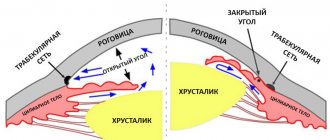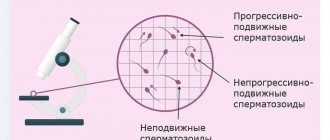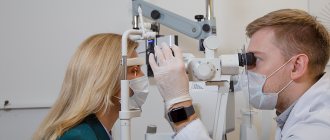Amblyopia is a disease of the visual organs, which is characterized by impaired visual functions and is accompanied by a progressive deterioration in visual acuity, color perception and the inability to focus the gaze. Amblyopia is also known as lazy eye syndrome.
If a person has amblyopia, they have problems with orientation in space: it becomes difficult to objectively assess the distances between objects, and the perception of volume and depth decreases. Increased stress on the healthy eye also leads to unpleasant consequences: patients complain of frequent headaches and a feeling of pain in the eyes.
Often, such phenomena are observed in only one eye; in practice, quite rarely there are cases when the lesion affects both eyes.
The peculiarity of the disease is that the retina and optic nerve, which are responsible for vision, are not damaged, but vision continues to decline. This is due to the fact that one eye perceives the picture much worse; the brain disconnects the affected eye from the vision process.
However, the preservation of the visual analyzer in a fully functioning state gives grounds for a favorable prognosis - the syndrome can be corrected, but only if treatment is carried out in the early stages of the disease.
Amblyopia or “lazy eye” is a decrease in visual acuity in an eye that does not have any external signs of disease. Neither examination of the anterior segment of the eye, the fundus, nor generally accepted examination methods usually indicate a problem. Amblyopia is diagnosed in childhood when testing visual acuity and is associated with insufficient development of the visual analyzer, when a defocused or unclear image appears on the retina.
Approximately 2% of the world's population suffers from amblyopia. This pathology most often develops in childhood and is often accompanied by other vision diseases.
What is amblyopia
Amblyopia is a persistent progressive decrease in vision in one or both eyes in the absence of pathological structural changes. Another name for the pathology is “lazy eye” syndrome.
Most often, with amblyopia, the visual function of one eye is suppressed. That is, a person perceives an image with only one healthy eye, monocularly, while the second eye does not participate in the visual process. In this case, we are not talking about blindness; the suppressed visual organ retains its functions. That is why the disease is considered reversible if treatment is started in time.
Amblyopia is a reversible disease, but it is important to start treatment on time
The suppressed eye gradually loses visual acuity, accommodative abilities and contrast sensitivity. Therefore, treatment for amblyopia must begin as early as possible, before all visual functions in the affected eye are impaired.
In rare cases, amblyopia can affect both eyes.
Hardware approach and eye gymnastics
Treatment is also carried out using special equipment. The visual organ with a deviation from the norm is stimulated by changing images, and exposure is also carried out using electricity and flash lamps. The method has proven effective when combined with physiotherapy, which helps improve metabolic processes in the body and activates the functioning of the optic nerve.
As for gymnastics, it has a supportive effect. In its pure form, exercise can restore vision only in the first stage of the disease. It is important to follow the doctor’s clear instructions, not to be lazy and perform the exercises conscientiously and daily. However, the result may only appear after several months of hard work. The convenient thing is that you can do them at home.
Causes of amblyopia
In fact, there are many reasons leading to the development of lazy eye syndrome. An ophthalmologist will be able to identify the exact cause only after a complete vision diagnosis. But experts identify the main risk factors that can cause amblyopia. Among them:
- Strabismus;
- Myopia, farsightedness, astigmatism;
- Eye injuries and retinal surgeries;
- Cerebral paralysis;
- Heredity or congenital abnormalities;
- Weakness of the accommodative apparatus;
- Incorrectly selected vision correction;
- Stress, hysterical states, psychosis.
Amblyopia can affect children with abnormal intrauterine development. For example, the disease is diagnosed in people with mental retardation, low birth weight, and prematurity. If during pregnancy the child’s mother smoked, took alcohol, drugs or medications contraindicated for pregnant women, the risk of developing amblyopia in the child increases several times.
However, experts note that amblyopia can also develop in people who do not have a genetic predisposition to the disorder.
Sign up for a free vision test
Types of amblyopia
The classification of the disorder depends on the causes of the “lazy eye” syndrome.
Refractive amblyopia
appears against the background of such visual disorders as farsightedness, myopia, astigmatism, anisometropia. Amblyopia develops due to the lack of a clear image on the retina.
Dysbinocular amblyopia
appears with strabismus. This is the most common cause of amblyopia. With strabismus, the eyes perceive two different images. The brain is not able to connect the image from both eyes and process the information received, so the image transmitted by the weaker eye is simply suppressed. In fact, the very principle of binocular vision, in which two images are compared by the brain into a single picture, is violated.
Obscurational amblyopia
People suffer from diseases that prevent the flow of rays to the retina of the eye - cataracts, cataracts, destruction of the vitreous body.
Dysbinocular amblyopia and refractive amblyopia are classified as primary types of disorder, obscuration is considered a secondary type.
Symptoms of amblyopia in children and adults
Amblyopia develops gradually and often goes unnoticed in the early stages. Moreover, the sooner treatment of the pathology begins, the better the results will be. This is why it is important to visit an ophthalmologist at least once a year, even if the patient is not worried about anything.
Children with amblyopia may appear clumsy and have trouble spatial awareness
General symptoms do not differ from other ophthalmological diseases - blurred vision, sensation of a foreign object in the eye, frequent headaches, increased fatigue with high visual load.
Symptoms more characteristic of amblyopia may appear already at a moderate and high degree of development of the disorder:
- There are difficulties with focusing at near and far distances;
- The ability to distinguish shades deteriorates;
- The outlines of objects may become blurred;
- The eyelid of the affected eye droops;
- To view an object, a person with amblyopia must cover the affected eye with the palm of their hand;
- The eyeball may make involuntary movements;
- Volumetric objects are more difficult to perceive.
Children may not be aware of their problems, so it is important for adults to monitor the child’s behavior and pay attention to characteristic changes in time.
For example, a child may tilt their head to the right or left to look at an object. Children with amblyopia have poor orientation and their movements may appear clumsy from the outside. With amblyopia, the affected eye may deviate to the side; this occurs when the child is concentrating on something. The easiest way to notice this deviation is when a child is watching a cartoon or reading.
An ophthalmologist can diagnose the disease only after a comprehensive examination. To detect possible violations in time, visit a specialist at least once a year! Children are recommended to undergo preventive examinations at least twice a year.
Book your child for an eye test
Our advantages
"Moscow Eye Clinic" offers comprehensive diagnostics and effective treatment of eye diseases. The use of modern equipment and the experience of specialists working in the clinic eliminate diagnostic errors.
Based on the results of the examination, each visitor will be given recommendations on choosing the most effective methods of treating the eye pathologies identified in them.
The high level of theoretical training and practical experience of our doctors guarantees the achievement of good treatment.
If you are interested in questions, you can ask specialists by phone 8 or on Skype, using the appropriate form on the website.
Treatment of amblyopia
The disease is reversible, but the effectiveness of treatment directly depends on the degree of the disorder. With mild to moderate amblyopia, the chances of curing the disease are quite good, but if amblyopia has reached a very high degree, treatment may be ineffective.
All treatment methods for amblyopia are aimed primarily at restoring binocular vision and increasing visual acuity in the visually impaired eye. The specialist chooses a method based on the degree of the disease and the cause of its occurrence.
Vision correction
If the cause of amblyopia is myopia, farsightedness or astigmatism, the first step is to correct your vision with glasses or contact lenses. It is important that the selection of correction is carried out by an experienced specialist, since incorrect diopters can also affect the development of lazy eye syndrome.
Amblyopia can be corrected with glasses or contact lenses
With the help of correction, the rays will focus on the retina correctly, this stimulates the “lazy” eye to independently engage in the visual process.
Occlusions
This method is used for almost any type of amblyopia. The bottom line is this: the healthy eye is closed using an occluder, that is, a safe pad made of plastic, rubber or fabric. This naturally awakens the amblyopic eye, it begins to work more intensely and is fully involved in the visual process.
Sign up for a free vision test
Hardware treatment (pleoptics)
Restoration of binocular vision in this case occurs through complex treatment using special computer programs and medical equipment.
Pleoptics course
allows you to restore binocular vision in case of advanced amblyopia.
Surgery
If amblyopia occurs as a result of strabismus, treatment may include surgery aimed at eliminating the factor in the development of lazy eye syndrome.
Current issues
Ë
È
Is surgery for strabismus performed on both eyes at once?
Sometimes both eyes are operated on at once; in some types of strabismus, only one eye is operated on.
Ë
È
Why is hardware treatment also recommended after surgery?
Surgery for strabismus is primarily a cosmetic remedy, since in itself it rarely restores binocular vision (when the brain combines two images received by the eyes into one). Each eye of a person with normal vision receives slightly different images (you can verify this by closing first one eye and then the other), which the brain combines into one. This does not happen with strabismus. In order for a person to see one picture and not two, surgery alone is not enough. The brain is not used to this kind of work. Therefore, to restore binocular (3D) vision, special exercises are necessary for a long time. At Excimer clinics, complex vision stimulation and hardware treatment help solve this problem.
Ë
È
How quickly can strabismus be cured?
Treatment of strabismus is a complex and lengthy process. Doctors recommend starting it as early as possible
| Ask a Question | All questions |
Sign up for an excimer clinic and learn more about your health!
You can call by phone
Or click the button and fill out the application form and receive a 5% discount on a full vision diagnostic
Make an appointment
Our address: Moscow, st. Marksistskaya, 3, building 1
"Excimer" on the map of the "Excimer" Clinic in other cities
conclusions
Lazy eye syndrome can appear for various reasons, but most often it is provoked by strabismus, myopia, farsightedness, astigmatism, cataracts and other ophthalmological diseases.
With amblyopia, the visual function of one eye (less often both) is suppressed, as a result of which binocular vision is impaired. Amblyopia can be treated in the early and middle stages of development, but the disease of a very high degree is almost impossible to cure.
To treat amblyopia, various methods are used, including vision correction, occlusion and pleoptics. The ophthalmologist chooses a method based on the causes of the disease and the degree of its development.
The sooner treatment begins, the higher the chances of complete vision restoration! Have a preventive examination with an ophthalmologist at least once a year and bring your children at least twice a year; only in this case can the disorder be detected and corrected in time.
Diagnostics
Early diagnosis of the disease (at the age of 3-4 years) makes it possible to cure amblyopia. Regular comprehensive examination by an ophthalmologist is the first step to identifying eye diseases and preventing their development.
An initial examination by a doctor makes it possible to determine the presence of signs of the disease. Additional examination using modern techniques makes it possible to accurately identify amblyopia, the causes of its occurrence, the degree of development of the disease and prescribe effective treatment.
Doctors use advanced diagnostic methods:
- Functional ophthalmic tests are performed to check visual acuity, color perception and perimetry.
- Carrying out biometric studies makes it possible to determine the angle of strabismus.
- Also used are studies of eye refraction, assessment of fixation, and accommodation. Various electrophysiological examination methods help to complete the picture of the disease.
- If necessary, for a more accurate and complete study of the course of the patient’s disease, an ultrasound of the eye, an MRI of the brain, and a consultation with a neurologist can be performed.
Visiting an ophthalmologist twice a year throughout the child’s growth and development, even in the absence of complaints, will eliminate the presence of pathologies or identify them in their infancy.










